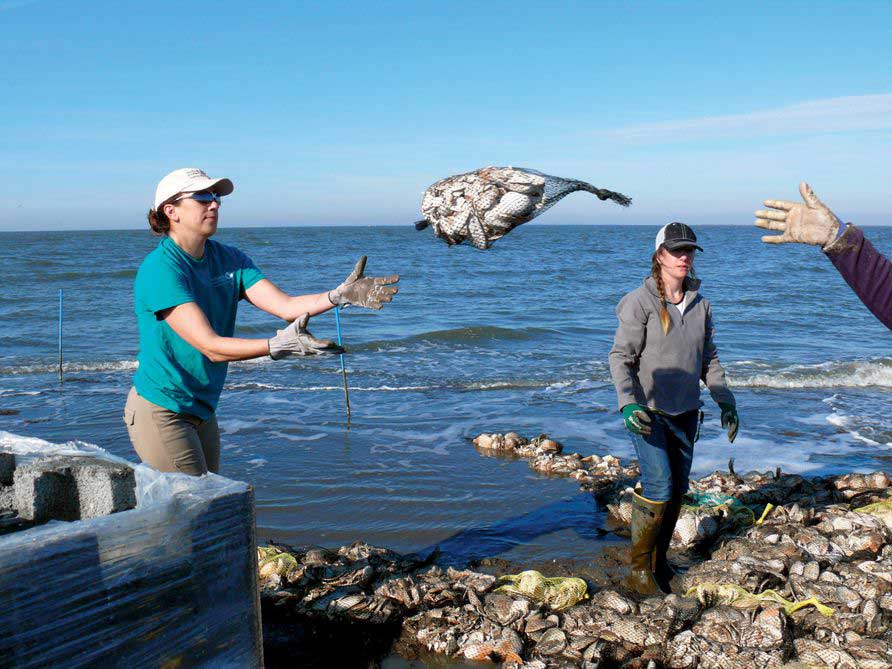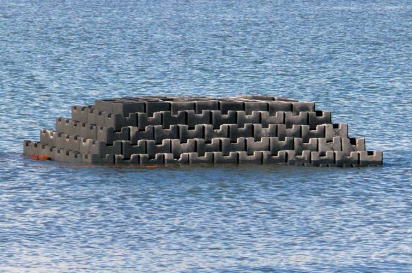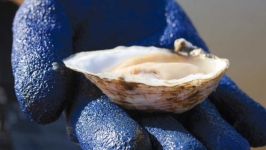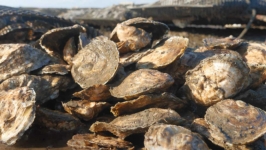Oyster Castles
Resembling castles made of oversized Lego-like concrete blocks, an oyster reef breakwater project meant to buffer a vulnerable shoreline has been taking shape just offshore in Cumberland County. Some 100 feet off Gandy’s Beach, oysters have begun attaching to two 20-foot-long, 10-foot-wide, seven-block-high structures. Other are beginning to grow on massed bags of recycled clam and oyster shells. In both cases, these oysters are not destined for the table.
Rather, they are instrumental to a living shoreline project designed to improve the ecology of the Delaware Bay while simultaneously protecting a stretch of eroding coastline that was hit especially hard by Hurricane Irene and Tropical Storm Lee in 2011, and then eroded further by Hurricane Sandy in 2012.
“I’ve been working in that area for ten years. “The amount of habitat loss—sandy beach and marsh that has eroded away— has been significant,” says Moses Katkowski, coastal project manager for The Nature Conservancy, which is heading the project in partnership with the U.S. Fish and Wildlife Service, the Partnership for the Delaware Estuary, and Rutgers University’s Haskin Shellfish Research Laboratory. “By some estimates, we’re losing about an acre a day of the 140,000 acres of tidal marsh in the Delaware estuary.”
The effort to build a 3,000-foot reef, stage two of which will begin this spring, is funded by $880,000 awarded to the U.S. Fish and Wildlife Service from Department of the Interior Hurricane Sandy resilience funds. The money will cover materials and labor costs, as well as ongoing scientific monitoring of bay wildlife and vegetation. Additionally, sensors attached to both sides of the reef will collect wave height data to determine how significantly the structure reduces wave energy. Among other benefits, one hope is that the nearshore oyster reef will create conditions that are ideal for horseshoe crab breeding.
This is not the only project of its kind in the state, but one of the first. A similar but smaller oyster reef was constructed in April 2015 at South Reeds Beach in Cape May County, spearheaded by the American Littoral Society and the Conserve Wildlife Foundation of New Jersey.
At Gandy’s Beach, oyster bagging efforts are about halfway to their goal of 15,000 bags of shells. In spring 2016, helping hands will come from volunteer ROTC groups and Cumberland and Atlantic County schoolchildren. The effort is being led by Project PORTS (Promoting Oyster Restoration Through Schools), run by Lisa Calvo at the Haskin Shellfish Research Lab.
To date, most of the recycled shells have come from surf clam processor LaMonica Fine Foods in Millville. Doing his part, Katkowski makes weekly trips to Dock’s Oyster House in Atlantic City. “I’m picking up 100 to 150 gallons of oyster shells a week,” he says. Many times that multitude of shells are thrown away weekly at the state’s many seafood restaurants— leaving ample opportunity for a Jersey-based oyster shell recycling program, similar to one that has been aiding the Chesapeake Bay for years.








